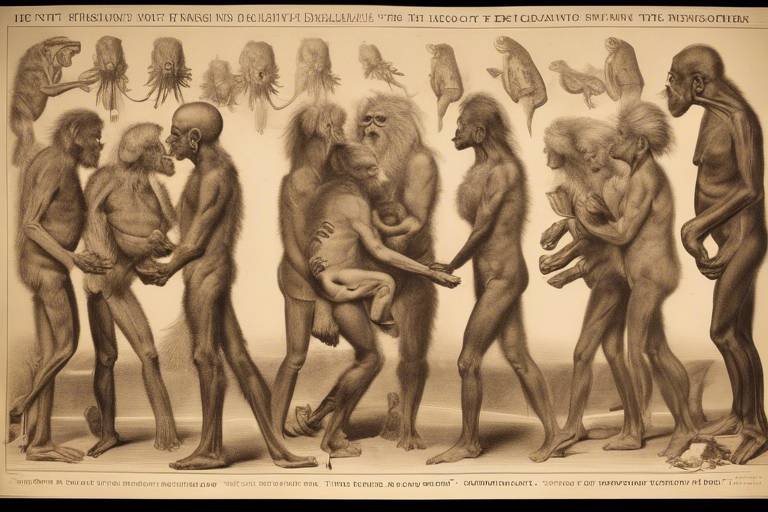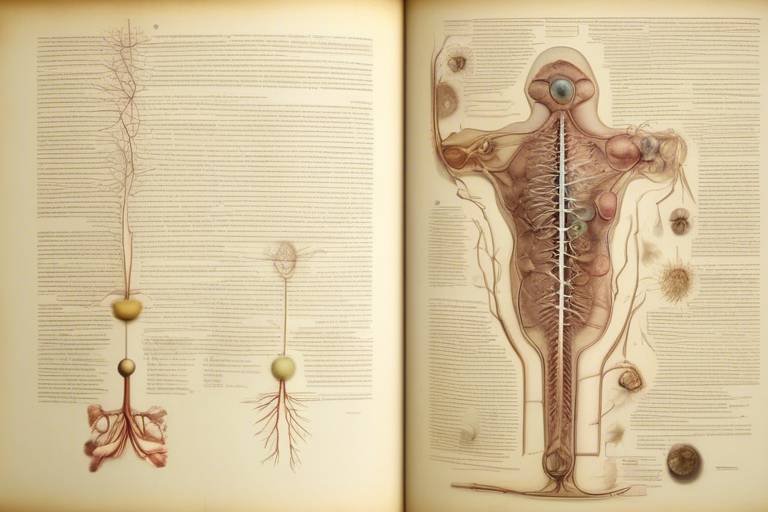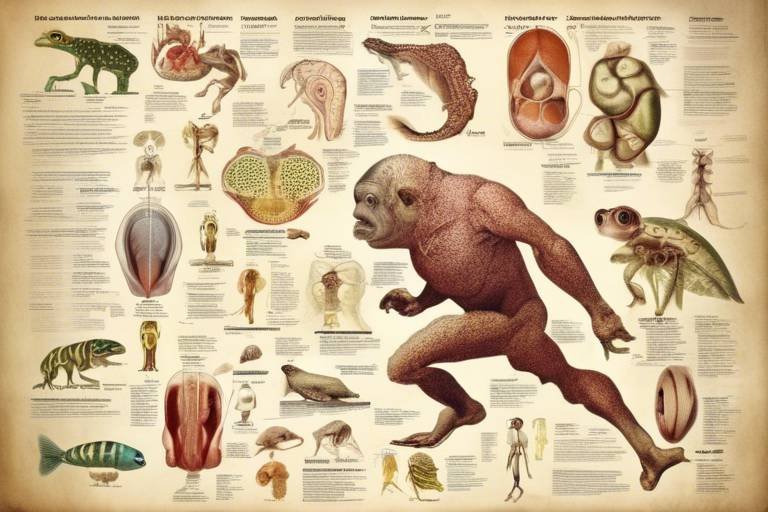Are Viruses Alive? A Philosophical and Scientific Exploration
The question of whether viruses are alive has puzzled scientists and philosophers alike for decades. Some argue that viruses are mere biological particles, while others contend they possess characteristics that qualify them as living entities. This debate is not just a matter of semantics; it touches on the very essence of what it means to be alive. To understand this complex issue, we must first explore the traditional definitions of life and how viruses fit—or don't fit—into these categories.
When we think about life, we often refer to a set of criteria that include growth, reproduction, response to stimuli, and metabolism. These characteristics help delineate living organisms from inanimate objects. However, viruses seem to challenge these definitions. They lack the cellular structure typical of living organisms and do not possess metabolic pathways. Instead, they exist in a state of limbo, requiring a host cell to replicate and exhibit any form of life-like behavior. This raises a critical question: if something cannot independently carry out the functions of life, can it truly be considered alive?
Viruses are intriguing entities that exist on the border between living and non-living. Structurally, they consist of genetic material—either DNA or RNA—encased in a protein coat called a capsid. This simplicity is part of what makes them so unique. Unlike cellular organisms, which have complex structures and functions, viruses are essentially just genetic information wrapped in a shell. This minimalistic design leads to their classification as non-living particles by many scientists.
To delve deeper, let's examine the basic components of viruses. The genetic material they carry is crucial for their replication process. When a virus infects a host cell, it injects its genetic material, hijacking the host's cellular machinery to produce more viruses. This parasitic behavior is a hallmark of viruses, further complicating their classification. Here's a breakdown of the main components:
| Component | Description |
|---|---|
| Genetic Material | Either DNA or RNA that carries the virus's genetic information. |
| Capsid | A protein coat that protects the genetic material and aids in the infection process. |
| Envelope (in some viruses) | A lipid layer that surrounds some viruses, derived from the host cell membrane. |
Viruses can be categorized based on various factors, including their structure and replication methods. Understanding these categories helps illustrate the diversity among viral forms, which complicates the definition of life. For example:
- DNA Viruses: These viruses contain DNA as their genetic material and replicate using the host's cellular machinery.
- RNA Viruses: These viruses use RNA and often have a higher mutation rate, making them particularly adaptable.
- Retroviruses: A subtype of RNA viruses that can integrate their genetic material into the host's DNA.
Viruses reproduce by invading host cells, effectively turning them into factories for viral replication. This mechanism raises questions about their classification. If they cannot reproduce independently, can they be deemed alive? This parasitic behavior is a key factor in the ongoing debate about the nature of viruses. While they can cause diseases, they also play essential roles in ecosystems, which brings us to their broader implications.
The philosophical discourse surrounding viruses adds another layer to this debate. Some argue that life is defined by the ability to adapt, evolve, and interact with the environment. From this perspective, viruses could be seen as a form of life. Others contend that life must be self-sustaining and capable of independent reproduction. These differing viewpoints influence our understanding of viruses and their place in the biological hierarchy.
Despite their controversial classification, viruses play significant roles in ecosystems. They are involved in nutrient cycling, helping to decompose organic matter and recycle nutrients back into the environment. Furthermore, they act as population control agents for bacteria and other microorganisms, maintaining ecological balance. This ecological perspective suggests that viruses are more than just pathogens; they are integral components of the biosphere.
Viruses also hold evolutionary significance. They can facilitate gene transfer between organisms, which can lead to new traits and adaptations. This role in evolution challenges the traditional view of viruses as mere parasites and positions them as active players in the evolutionary narrative of life on Earth.
Understanding the nature of viruses has profound implications for medicine and research. The classification of viruses affects how we approach treatment strategies for viral diseases. If we consider viruses as living entities, it could influence vaccine development and antiviral therapies. Therefore, grasping their true nature is crucial for advancing medical science and public health.
- Are viruses considered living organisms? The classification of viruses as living or non-living is a subject of ongoing debate among scientists.
- What role do viruses play in ecosystems? Viruses contribute to nutrient cycling and population control, playing essential roles in ecological balance.
- How do viruses replicate? Viruses replicate by hijacking host cells and using their machinery to produce new viral particles.
- Can viruses evolve? Yes, viruses can evolve through mutations and gene transfer, impacting their adaptability and survival.

alive
This article delves into the ongoing debate surrounding the status of viruses, examining scientific evidence and philosophical perspectives on what it means to be in the context of viruses.
Understanding the criteria that define life is essential to the discussion. This section explores traditional biological definitions and how they apply to viruses, revealing the complexities of categorizing living entities.
This section investigates the nature of viruses, discussing their structure and function. It contrasts viruses with cellular organisms, highlighting the unique characteristics that challenge conventional definitions of life.
Examining the basic components of viruses, this section describes their genetic material and protein coats, emphasizing how these features contribute to their classification as non-living entities.
This subsection categorizes viruses based on their structure and replication methods, illustrating the diversity among viral forms and their implications for the definition of life.
An exploration of how viruses reproduce by hijacking host cells, this section discusses the implications of this parasitic behavior on their classification as living or non-living.
This section delves into philosophical arguments regarding life, examining how different viewpoints influence our understanding of viruses and their place in the biological hierarchy.
Investigating the ecological impact of viruses, this section discusses their roles in nutrient cycling and population control, suggesting that their influence extends beyond mere pathogenicity.
This subsection explores the evolutionary significance of viruses, considering their role in gene transfer and the implications for the evolution of life on Earth.
This section highlights how the classification of viruses affects medical research and treatment strategies, emphasizing the importance of understanding their nature in combating viral diseases.
- Are viruses considered living organisms? The debate continues, as viruses exhibit characteristics of both living and non-living entities.
- How do viruses replicate? Viruses replicate by hijacking the cellular machinery of a host organism.
- What role do viruses play in ecosystems? Viruses contribute to nutrient cycling and can control populations of bacteria and other microorganisms.
- Can viruses evolve? Yes, viruses can evolve, often rapidly, which poses challenges for treatment and prevention.

in the context of viruses.
This article delves into the ongoing debate surrounding the status of viruses, examining scientific evidence and philosophical perspectives on what it means to be alive in the context of viruses.
Understanding the criteria that define life is essential to the discussion. This section explores traditional biological definitions and how they apply to viruses, revealing the complexities of categorizing living entities.
This section investigates the nature of viruses, discussing their structure and function. It contrasts viruses with cellular organisms, highlighting the unique characteristics that challenge conventional definitions of life.
Examining the basic components of viruses, this section describes their genetic material and protein coats, emphasizing how these features contribute to their classification as non-living entities.
This subsection categorizes viruses based on their structure and replication methods, illustrating the diversity among viral forms and their implications for the definition of life.
An exploration of how viruses reproduce by hijacking host cells, this section discusses the implications of this parasitic behavior on their classification as living or non-living.
This section delves into philosophical arguments regarding life, examining how different viewpoints influence our understanding of viruses and their place in the biological hierarchy.
Investigating the ecological impact of viruses, this section discusses their roles in nutrient cycling and population control, suggesting that their influence extends beyond mere pathogenicity.
This subsection explores the evolutionary significance of viruses, considering their role in gene transfer and the implications for the evolution of life on Earth.
This section highlights how the classification of viruses affects medical research and treatment strategies, emphasizing the importance of understanding their nature in combating viral diseases.
- Are viruses considered living organisms? - The debate continues, with some arguing they are non-living particles due to their inability to reproduce independently.
- How do viruses replicate? - Viruses must infect a host cell to replicate, hijacking the cell's machinery to produce more viruses.
- What role do viruses play in ecosystems? - Viruses contribute to nutrient cycling and can influence population dynamics among various organisms.
- Can viruses evolve? - Yes, viruses can evolve rapidly, which is one reason they can adapt to new hosts and environments.

The Definition of Life
Understanding the criteria that define life is essential to the discussion of whether viruses can be considered alive. Traditionally, life is characterized by several key features, including the ability to grow, reproduce, respond to stimuli, and maintain homeostasis. These characteristics are often used as a yardstick to measure the vitality of any organism, but when it comes to viruses, things get a bit murky. Are they merely biological entities, or do they straddle the line between life and non-life?
To grasp the complexities of this debate, let’s break down the traditional definitions of life. Most biologists agree that living organisms must possess the following attributes:
- Cellular Organization: Living organisms are made up of cells, which are considered the basic units of life.
- Metabolism: They must possess a metabolism, meaning they can convert energy from their environment to sustain their activities.
- Growth and Development: Living entities undergo regulated growth and development, following a specific genetic blueprint.
- Reproduction: They have the ability to reproduce, either sexually or asexually, to ensure the continuation of their species.
- Response to Stimuli: Living organisms can respond to environmental changes, adapting to survive.
- Homeostasis: They maintain a stable internal environment despite external fluctuations.
Now, let’s consider viruses. While they contain genetic material and can reproduce, they do so only by hijacking the cellular machinery of host organisms. This parasitic behavior raises a critical question: can something that relies entirely on another entity for reproduction and metabolism truly be classified as alive? Unlike bacteria or fungi, which exhibit all the characteristics mentioned above, viruses lack the cellular structure and metabolic processes that are typically associated with life.
Interestingly, some scientists argue that viruses should be viewed through a different lens. They propose that viruses represent a unique form of life that exists in a gray area, challenging our conventional understanding. For instance, one could liken viruses to a computer program: they are inert when not within a host, yet once they invade a living cell, they spring into action, replicating and evolving. This analogy prompts us to reconsider the boundaries of life itself. Are we too rigid in our definitions? Or is it time to broaden our horizons and embrace the complexity of biological existence?
In light of these discussions, the definition of life becomes a philosophical quandary as much as it is a scientific one. The implications of categorizing viruses as living or non-living can ripple through various fields, from ecology to medicine. As we continue to explore the nature of viruses, we may find that the very essence of what it means to be alive is more intricate than we ever imagined.

Viruses: Biological Entities or Simple Particles?
The ongoing debate about whether viruses are biological entities or merely simple particles has fascinated scientists and philosophers alike. At first glance, it might seem straightforward; after all, viruses do not exhibit many characteristics typically associated with life. However, as we delve deeper into their structure and behavior, the lines begin to blur, leading to intriguing questions about what it truly means to be "alive."
Viruses are often described as acellular, meaning they lack the cellular structure that characterizes all living organisms. Unlike bacteria, fungi, and plants, viruses do not possess the machinery necessary for metabolism or reproduction. Instead, they consist of a core of genetic material—either DNA or RNA—enclosed in a protein coat, known as a capsid. This minimalist design raises questions about their classification. Are they merely complex molecules, or do they represent a unique form of life?
One of the key factors that set viruses apart from cellular organisms is their dependency on host cells for replication. Unlike living organisms that can reproduce independently, viruses must invade a host cell, hijacking its machinery to produce new viral particles. This parasitic behavior challenges our traditional definitions of life, which often emphasize self-sufficiency and autonomy. So, can we consider something alive if it cannot exist or replicate without exploiting another organism?
To better understand this debate, consider the following comparison:
| Characteristic | Viruses | Living Organisms |
|---|---|---|
| Cell Structure | Acellular | Cellular |
| Metabolism | None | Active metabolism |
| Reproduction | Requires a host | Independent |
| Response to Stimuli | None | Yes |
This table illustrates the stark differences between viruses and living organisms, yet it also highlights the complexities of categorizing viruses. Some scientists argue that the ability of viruses to evolve and adapt to their environments is a hallmark of life. They can change rapidly, developing resistance to antiviral drugs or adapting to new hosts, which suggests a level of biological activity that challenges their classification as mere particles.
Furthermore, the role of viruses in ecosystems cannot be overlooked. They play significant roles in nutrient cycling and population control, impacting both microbial communities and larger organisms. This ecological significance adds another layer to the discussion, suggesting that their influence extends beyond pathogenicity and into the broader context of life on Earth.
In conclusion, the question of whether viruses are biological entities or simple particles is not merely academic; it has profound implications for our understanding of life itself. As we continue to explore the nature of viruses, we must grapple with the complexities of categorization and the philosophical questions that arise from this debate. Are viruses a bridge between the living and non-living worlds, or do they represent a unique category all their own? The exploration of these questions not only enriches our understanding of viruses but also challenges us to rethink the very foundations of what it means to be alive.

Structure of Viruses
When we talk about the , we’re diving into a fascinating world that challenges our conventional understanding of what it means to be "alive." At first glance, viruses appear to be mere simple particles, lacking the complex machinery that defines cellular life. However, their structure is both unique and sophisticated, comprising two essential components: genetic material and a protein coat.
The genetic material can be either DNA or RNA, and this is what carries the instructions for making new virus particles. Unlike living organisms that possess both DNA and RNA, viruses are more streamlined; they usually contain only one type of genetic material. This simplicity is what makes them so efficient at hijacking host cells. The protein coat, or capsid, protects the viral genetic material and aids in the attachment and entry into host cells. Think of the capsid as a secure package that delivers the virus's genetic instructions right into the heart of a living cell.
To better understand the structural components of viruses, let’s break it down:
| Component | Description |
|---|---|
| Genetic Material | Can be DNA or RNA, serving as the blueprint for viral replication. |
| Protein Coat (Capsid) | Encases the genetic material and facilitates entry into host cells. |
| Envelope (in some viruses) | A lipid layer that surrounds the capsid, aiding in cell entry and immune evasion. |
Some viruses also possess an outer envelope, which is derived from the host cell's membrane. This envelope can make viruses more adept at evading the immune system, allowing them to infiltrate host cells more efficiently. Imagine it as a stealth cloak that helps the virus sneak past the body's defenses. The presence of this envelope can influence how a virus spreads and how effectively it can be targeted by treatments.
In summary, the structure of viruses is a compelling mix of simplicity and efficiency. Their ability to replicate using the host's cellular machinery raises profound questions about their classification as living entities. Are they simply biological entities or do they represent a unique category that straddles the line between life and non-life? This ongoing debate continues to intrigue scientists and philosophers alike, as we seek to understand the very essence of what it means to be alive.
- What are viruses made of? Viruses are primarily made of genetic material (either DNA or RNA) and a protein coat called a capsid. Some viruses also have an outer lipid envelope.
- Are viruses considered living organisms? This is a debated topic; while they have some characteristics of life, such as the ability to reproduce, they lack cellular structure and metabolic processes.
- How do viruses replicate? Viruses replicate by invading a host cell and using the cell's machinery to produce new virus particles.

Types of Viruses
When we dive into the fascinating world of viruses, we quickly realize that they are not just one-size-fits-all entities. Instead, they come in a variety of forms, each with unique characteristics and behaviors that challenge our understanding of life itself. Viruses can broadly be categorized based on their structure, genetic material, and replication mechanisms. This classification sheds light on their diverse roles in ecosystems and their interactions with host organisms.
At the core of viral classification lies the distinction between DNA viruses and RNA viruses. DNA viruses carry their genetic information in the form of DNA, while RNA viruses use RNA for their genetic material. This fundamental difference influences how they replicate and how they interact with their hosts. For instance, DNA viruses tend to have more stable genomes, which allows them to integrate into the host's DNA and persist over longer periods. In contrast, RNA viruses often mutate rapidly, leading to a high degree of variability, which can make them particularly challenging to combat.
Furthermore, viruses can be categorized based on their shape and structure. Some of the most common types include:
- Helical viruses: These have a rod-like structure and their genetic material is coiled within a cylindrical protein coat.
- Icosahedral viruses: These exhibit a spherical shape made up of equilateral triangles, forming a robust shell around their genetic material.
- Complex viruses: These have intricate structures that do not fit neatly into the previous categories, often featuring additional components like tails or envelopes.
Another important classification is based on the method of replication. Some viruses are referred to as lytic viruses, which means they enter a host cell, replicate rapidly, and then cause the cell to burst, releasing new viral particles. Others are lysogenic viruses, which integrate their genetic material into the host's genome, allowing them to replicate along with the host cell's DNA without immediately causing harm. This ability to remain dormant can lead to later outbreaks, making them particularly intriguing from both a scientific and medical perspective.
Understanding these types of viruses not only enhances our knowledge of their biological roles but also informs our approach to treatment and prevention of viral diseases. For instance, the rapid mutation rates in RNA viruses can lead to challenges in vaccine development, while the stability of DNA viruses may allow for more effective long-term treatments. Thus, recognizing the various types of viruses is crucial for both scientific inquiry and public health strategies.

Replication Mechanisms
The replication of viruses is one of the most fascinating yet perplexing aspects of their existence. Unlike living organisms that can reproduce independently, viruses require a host cell to replicate. This relationship can be likened to a thief breaking into a house to steal its valuables; the virus invades the host cell, hijacking its machinery to produce new viral particles. This parasitic behavior raises a fundamental question: if viruses cannot reproduce on their own, can they truly be considered alive?
To understand how viruses replicate, it’s essential to explore the various stages of their life cycle. The process can be broken down into several key phases:
- Attachment: The virus attaches itself to a specific receptor on the surface of a susceptible host cell. This specificity is crucial as it determines which cells the virus can infect.
- Pentration: After attachment, the virus enters the host cell, often through endocytosis or direct fusion with the cell membrane. Once inside, it sheds its protein coat, releasing its genetic material.
- Replication and Transcription: The viral genetic material, whether DNA or RNA, takes control of the host's cellular machinery. It replicates itself and produces messenger RNA (mRNA) that codes for viral proteins.
- Assembly: Newly synthesized viral components are assembled into complete virions (virus particles) within the host cell.
- Release: Finally, the newly formed viruses exit the host cell, often destroying it in the process. They can then go on to infect other cells, continuing the cycle.
This entire process highlights the intricate relationship between viruses and their hosts. While some may argue that this behavior is indicative of life, others contend that the inability to self-replicate without a host disqualifies them from being classified as living organisms. The debate is ongoing, with scientists and philosophers alike pondering the implications of this unique replication mechanism.
Moreover, the diversity in replication strategies among different types of viruses adds another layer of complexity to the discussion. For instance, some viruses, like retroviruses, utilize reverse transcription to convert their RNA into DNA before integrating it into the host's genome. This can lead to long-term infections and has significant implications for viral evolution and host interactions.
In summary, the replication mechanisms of viruses challenge our traditional notions of life. While they exhibit some characteristics of living organisms, their reliance on host cells for reproduction complicates their classification. This ongoing debate not only fascinates scientists but also raises important questions about the nature of life itself.
- Can viruses be considered alive? The debate continues, with arguments on both sides regarding their classification as living or non-living entities.
- How do viruses replicate? Viruses replicate by hijacking the machinery of host cells, which involves several stages including attachment, penetration, replication, assembly, and release.
- What are the implications of viral replication for medicine? Understanding how viruses replicate is crucial for developing effective treatments and vaccines against viral diseases.

Philosophical Perspectives on Life
When we ponder the question of whether viruses are alive, we inevitably step into the realm of philosophy. This discipline encourages us to explore the very essence of life and what it means to exist. Philosophers have long debated the criteria that define life, leading to various interpretations that can help us understand where viruses fit into this complex puzzle. One might ask, "If something can replicate, does that make it alive?" This question is at the heart of the debate surrounding viruses.
To delve deeper, we can look at two primary philosophical perspectives: the biological essentialism viewpoint and the more existential perspective. Biological essentialists argue that life is defined by specific characteristics such as metabolism, growth, and reproduction. By this definition, viruses fall short; they lack the machinery to reproduce independently and rely on host cells to replicate. This perspective could lead us to classify viruses as mere biological anomalies rather than living entities.
On the other hand, the existential perspective invites us to consider the broader implications of existence. It challenges the rigid definitions set by biological essentialism and asks us to think about the interconnectedness of life. From this angle, viruses could be viewed as part of a larger ecosystem, contributing to the balance of life on Earth. They interact with living organisms in ways that are crucial for evolutionary processes, such as gene transfer, which can lead to significant changes in host species over time.
Moreover, the philosophical inquiry doesn't stop at definitions. It also encompasses ethical considerations. If we categorize viruses as non-living, does that absolve us from responsibility for their impacts on human health and the environment? Alternatively, if we accept them as living entities, what responsibilities do we have to understand and manage their roles in our ecosystems? These questions force us to confront our assumptions about life and the implications of those assumptions on our actions and policies.
In summary, the philosophical perspectives on life offer a rich tapestry of ideas that challenge our understanding of viruses. They compel us to reconsider what it means to be alive and highlight the importance of context in our definitions. As we continue to explore these questions, we may find that the lines between living and non-living are not as clear-cut as we once thought, and that viruses, in their own unique way, play a vital role in the grand narrative of life.
- Are viruses considered living organisms?
Viruses are often classified as non-living entities because they cannot reproduce independently and lack cellular structures. - What role do viruses play in ecosystems?
Viruses contribute to nutrient cycling and can influence population dynamics, making them important players in ecological balance. - How do philosophical perspectives impact our understanding of viruses?
Philosophical viewpoints challenge traditional definitions of life, prompting us to reconsider the role and significance of viruses in the biological hierarchy.

The Role of Viruses in Ecosystems
When we think about ecosystems, our minds often drift to majestic trees, bustling animals, and the intricate web of life that thrives within. However, lurking in the shadows of this vibrant tableau are viruses, tiny entities that play a surprisingly significant role in maintaining ecological balance. You might ask, how can something so small, often associated with disease, contribute positively to the environment? Well, let's dive into the fascinating world of viruses and uncover their ecological importance.
Viruses are not just agents of illness; they are also key players in nutrient cycling. In aquatic environments, for instance, viruses infect and lyse (break down) bacterial cells, releasing nutrients back into the water. This process is crucial because it helps recycle carbon, nitrogen, and phosphorus, making these essential elements available for other organisms. Without viruses, the buildup of bacterial biomass could lead to a collapse of the ecosystem. Essentially, viruses act as nature's cleanup crew, ensuring that nutrients are continually cycled through the environment.
Moreover, viruses contribute to population control among microorganisms. By targeting specific bacterial populations, they help maintain a balance within microbial communities. This balance is vital for the overall health of ecosystems, as it prevents any one species from dominating and allows for greater biodiversity. For example, in marine ecosystems, viral infections can regulate phytoplankton populations, which are foundational to the food web. This regulation not only supports fish populations but also affects the entire marine ecosystem.
Interestingly, viruses also facilitate gene transfer among organisms, a process known as horizontal gene transfer. This mechanism can lead to increased genetic diversity, which is essential for adaptation and evolution. For instance, when a virus infects a bacterium, it can inadvertently transfer genetic material from one bacterium to another. This exchange can confer new traits, such as antibiotic resistance or the ability to metabolize different substances, thereby enhancing the adaptability of microbial communities. In this way, viruses are not just passive players; they actively shape the evolution of life on Earth.
In addition to their ecological roles, viruses also serve as indicators of environmental health. Changes in viral populations can signal shifts in ecosystem dynamics, providing valuable insights into the impacts of climate change, pollution, and other anthropogenic factors. Researchers often study viral communities to gauge the overall health of marine and terrestrial ecosystems, making them a vital component of ecological monitoring.
In conclusion, while viruses may often be viewed through the lens of disease and infection, their roles in ecosystems are multifaceted and essential. They contribute to nutrient cycling, population control, gene transfer, and even serve as indicators of environmental health. Understanding these roles not only broadens our perspective on viruses but also highlights the intricate connections that exist within the web of life. So, the next time you hear about viruses, remember that they are not merely villains in the story of life; they are also unsung heroes of the ecosystem.
- What is the role of viruses in nutrient cycling?
Viruses help recycle nutrients by infecting and breaking down bacterial cells, releasing essential elements back into the environment. - How do viruses control populations in ecosystems?
By infecting specific bacteria and other microorganisms, viruses help maintain balance and prevent any one species from dominating. - Can viruses contribute to evolution?
Yes, viruses facilitate horizontal gene transfer, increasing genetic diversity and enabling organisms to adapt to changing environments. - Are viruses harmful to ecosystems?
While they can cause disease, viruses also play crucial roles in maintaining ecological balance and health.

Viruses and Evolution
When we think about evolution, we often picture a grand tapestry of life, woven with the threads of genetic material passed down through generations. But where do viruses fit into this intricate design? Surprisingly, viruses may play a pivotal role in the evolutionary narrative, acting as both catalysts for change and as agents of genetic exchange. They possess a unique ability to transfer genes between different organisms, a process known as horizontal gene transfer. This phenomenon can introduce new traits into a host's genome, potentially accelerating evolution.
To understand this better, consider the following points:
- Gene Transfer: Viruses can carry genetic material from one organism to another, which can lead to significant changes in the recipient's DNA.
- Adaptation: The rapid mutation rates of viruses enable them to adapt quickly to environmental pressures, which can influence the evolution of their hosts.
- Co-evolution: The relationship between viruses and their hosts often leads to a co-evolutionary arms race, where both parties evolve in response to each other's adaptations.
For example, the HIV virus has been observed to evolve rapidly, developing resistance to treatments while simultaneously exerting evolutionary pressure on the human immune system. This dance of evolution highlights the complex interplay between viruses and their hosts, suggesting that viruses are not merely pathogens but also important players in the evolutionary game.
Moreover, some scientists propose that viruses might have even contributed to the origin of life itself. Theories such as the RNA world hypothesis suggest that early life forms could have been similar to modern viruses, relying on RNA for replication. This raises fascinating questions about the very nature of life and the role viruses might have played in shaping the evolutionary pathways we observe today.
In summary, the relationship between viruses and evolution is multifaceted and profound. As we continue to explore this relationship, it becomes increasingly clear that viruses are not just simple invaders; they are integral components of the evolutionary process, influencing genetic diversity and adaptation in ways we are only beginning to understand.
- Are viruses considered living organisms? While viruses exhibit some characteristics of life, such as the ability to evolve, they lack the cellular structure and metabolic processes that define living organisms.
- How do viruses contribute to evolution? Viruses can facilitate gene transfer between different species, introducing new genetic material that can lead to evolutionary changes.
- Can viruses evolve? Yes, viruses can mutate rapidly, allowing them to adapt to new environments and hosts, which is a key aspect of their evolutionary strategy.

Implications for Medicine and Research
When it comes to the world of medicine and research, the classification of viruses as living or non-living entities has profound implications. Understanding whether viruses are alive shapes our approach to treating viral infections and developing vaccines. If we consider viruses as living organisms, it might lead us to explore more aggressive methods of intervention, akin to how we deal with bacterial infections. Conversely, viewing them as non-living could steer us towards more innovative strategies that focus on preventing their replication rather than outright elimination.
One of the most significant implications of this classification is seen in the realm of vaccine development. Vaccines are designed to prepare the immune system to recognize and combat pathogens. If viruses are viewed through the lens of life, researchers may prioritize creating vaccines that mimic the way living organisms interact with the immune system. For instance, live attenuated vaccines use weakened forms of the virus, which can elicit a robust immune response. On the other hand, inactivated vaccines use dead viruses, which might be less effective in some cases. This distinction hinges on our understanding of the virus's nature.
Additionally, the ongoing battle against emerging viral diseases, such as COVID-19, has underscored the need for a nuanced understanding of viruses. The rapid mutation rates of viruses challenge traditional vaccine strategies, and this is where research into their classification becomes crucial. For example, if we can grasp how viruses evolve and adapt, we may be able to anticipate future mutations and develop more effective vaccines. This requires a collaborative effort between virologists, immunologists, and epidemiologists, all working together to decode the mysteries of these elusive entities.
Furthermore, the implications extend to therapeutic interventions. Antiviral drugs often target specific stages of the viral life cycle, such as entry into host cells or replication. If we redefine our understanding of viruses, it could lead to the discovery of novel antiviral agents that exploit the unique characteristics of viruses. For instance, researchers are investigating the use of CRISPR technology to edit viral genomes directly, which could revolutionize how we combat viral infections.
Moreover, the classification of viruses as living or non-living also raises ethical questions in the field of gene therapy. As scientists explore the potential of using viruses as vectors to deliver genetic material into cells, the moral implications of manipulating these entities become more pronounced. Are we playing with forces of nature, or are we simply utilizing tools that, while complex, do not possess life in the traditional sense?
In summary, the implications of how we perceive viruses resonate throughout the fields of medicine and research. Whether we view them as living organisms or mere particles shapes our strategies for treatment, prevention, and understanding of viral diseases. As we advance our research, it becomes increasingly important to consider not just the scientific facts, but also the broader philosophical questions surrounding the very essence of life itself.
- Are viruses considered living organisms? The debate continues, with some scientists arguing they are non-living due to their inability to replicate independently.
- How do viruses impact vaccine development? Their classification influences the approach researchers take in creating effective vaccines.
- What role do viruses play in gene therapy? Viruses can be engineered to deliver therapeutic genes, raising ethical considerations.
- Why is understanding viruses important for public health? Knowledge of viral behavior informs strategies to combat outbreaks and develop treatments.
Frequently Asked Questions
- What defines a living organism?
To be classified as a living organism, something generally needs to exhibit characteristics such as growth, reproduction, response to stimuli, and metabolism. These criteria help differentiate living things from non-living entities, creating a framework for understanding life.
- Are viruses considered living or non-living?
This is a hotly debated topic! Viruses do not meet all the traditional criteria for life, as they cannot reproduce independently and lack metabolic processes. Instead, they require a host cell to replicate, which leads many scientists to classify them as non-living entities.
- How do viruses replicate?
Viruses replicate by hijacking the cellular machinery of a host. Once a virus enters a host cell, it injects its genetic material, which then takes over the cell's functions to produce new virus particles. This parasitic behavior raises questions about their classification as living organisms.
- What are the different types of viruses?
Viruses can be categorized based on their structure and replication methods. Some common types include DNA viruses, RNA viruses, and retroviruses. Each type has unique characteristics that influence how they infect hosts and spread.
- What role do viruses play in ecosystems?
Viruses play crucial roles in ecosystems, including nutrient cycling and population control. They can influence microbial communities and even affect the health of larger organisms, demonstrating that their impact extends beyond simply causing diseases.
- How do viruses contribute to evolution?
Viruses can facilitate gene transfer between organisms, which may drive evolutionary changes. By integrating their genetic material into host genomes, they can introduce new traits that may be advantageous for survival, highlighting their role in the evolution of life on Earth.
- Why is understanding viruses important for medicine?
Understanding the nature of viruses is vital for developing effective medical treatments and vaccines. By knowing how viruses operate and replicate, researchers can create strategies to combat viral infections and improve public health outcomes.



















